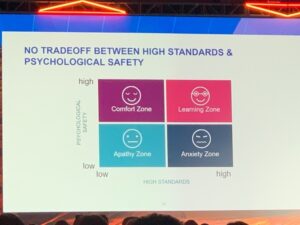Leadership Matters – Part III
If you have followed my last two blogs (Inspirational meeting and Equity, diversity and inclusion), you will know I recently attended the Association of American Medical Colleges (AAMC) Annual Meeting, Learn, Serve, Lead 2019, and wrote about the inspirational nature and content of the meeting. Many AAMC leaders and speakers spoke out strongly on issues of equity, diversity and justice and called leaders and faculty, staff and learners to activism and advocacy. My second blog in this series of three called on senior leaders to be accountable for advancing equity, diversity and inclusion.
Another theme at AAMC, as in past years, was the joint responsibility of medical schools and the health care system to provide an excellent clinical and learning environment for our medical learners, staff and faculty. I have spoken frequently about the fact the clinical environment and the learning environment are inextricably linked and the quality of care is reflected in the quality of clinical education and vice versa.
The speaker at the last plenary session was superb. Dr. Amy C. Edmondson, the Novartis Professor of Leadership and Management at the Harvard Business School, delivered an amazing talk, Fearless: Creating Psychological Safety for Learning, Innovation and Growth. A review of her biography documents her expertise in organizational learning, innovation and teamwork. Her most recent book is titled The Fearless Organization: Creating Psychological Safety in the Workplace for Learning, Innovation and Growth.
Now I know, as does Dr. Edmondson, that psychological safety for some has become a buzz phrase, and some think it is being overused. So, early in her talk she reiterated what psychological safety was not: about being nice; touchy-feely; a license to whine; freedom from conflict; and so on. However, she used logic and evidence to clearly argue that there was no tradeoff between high standards and psychological safety, as illustrated in the following graphic, and argued that it is incumbent on all leaders to expect both excellence in work and excellence in the working and learning environment.
One of the key challenges in our environment is the historical and current hierarchy of academic medicine. In 2007, Darrell Kirch, AAMC president emeritus, called for academic medicine to move from a culture that was hierarchical, autonomous, competitive, individualistic and expert-centered to a different culture that is collaborative, team-based, service-based, mutually accountable and patient-centered. In this talk, Dr. Edmondson illustrated we still have a long way to go!
One fascinating illustration about the importance of leadership in determining the work and learning environment was a study she co-led (Making it safe: The effects of leader inclusiveness and professional status on psychological safety and improvement efforts in health care teams). Like any great speaker and scientist, she used evidence to link hierarchy to psychological safety to clinical outcomes. I am sure you all can picture this argument being built, but just to be clear, higher levels of hierarchy led to worse communication and teamwork and was associated with worse clinical outcomes as well as lower workplace satisfaction.
As one might expect, the study demonstrated overall significant differences of levels of hierarchy from physicians to nurses to respiratory therapists across the 44 neonatal intensive care units studied. However, further analysis revealed that some units were flat! That certainly also implies some units were even more hierarchical. (You might be interested in The World is Flat by Thomas Friedman, copyright 2005. Recent events may belay that idea, but I digress!)
So, what was special about the units that were flat? Detailed analysis was done and many factors were considered. In the end, the only common factor in the units where the pecking order did not, in fact, exist was the presence of inclusive unit leaders. Leadership matters!
I need to clarify my ideas on leadership. By virtue of the organizations of which we are all a part, we have positional leadership. But much of what I have read about excellence in leadership in organizations is that leadership is something everyone does. The custodian on the word can change a clinical outcome by speaking up. The learner will challenge the consensus on teams and often be right.
For me, this study and Dr. Edmondson’s talk illustrate that all positional leaders must be inclusive, collaborative and must welcome feedback and dissent. More importantly, it illustrates the importance of front-line leadership and the importance for our patients and our learners that we provide inclusive, respectful, collaborative leadership.
So, as always, I invite your feedback here on my blog. I would also be happy to hear from you face-to-face, and would welcome the opportunity to attend your department or unit meeting and travel to your community.
See also:
Inspirational Meeting – Leadership Matters Part I
Equity, diversity and inclusion – Leadership Matters Part II


